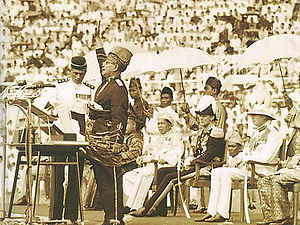Merdeka

Merdeka (Jawi: مرديک; Indonesian: [mərˈdɛka], Malay: [mərdeka]) is a term in Indonesian and Malay which means "independent" or "free". It is derived from the Sanskrit maharddhika (महर्द्धिक) meaning "rich, prosperous, and powerful". In the Malay Archipelago, this term had acquired the meaning of a freed slave. The term is also used in other Indonesian languages.
The term Mardijker is a Dutch corruption of the Portuguese version of the original Sanskrit words and was used to designate former Portuguese and Dutch slaves from India in the East Indies, known as
The term was used by the anti-colonialist and pro-independence movements in the
Indonesia

The term "merdeka" was used in Indonesia in a similar way to designate freedom from the Dutch colonial government during the struggle for independence in the 1940s.[4] Republic of Indonesia declared its Hari Kemerdekaan Indonesia or Proclamation of Indonesian Independence on 17 August 1945, and it has become national holiday and commemorated annually ever since.
During the
On 1 September it was mentioned by the president Sukarno in his short speech:
"Since today we will cry out loud, "Merdeka!" Continue on that loud battle cry, as the soul calls out loud for freedom! A soul of freedom, one of fighting and working spirit! TO FIGHT AND TO WORK! Prove it!"
"Merdeka" is also used in Indonesia Raya, the national anthem of Indonesia:
Indonesia Raya, merdeka, merdeka! Tanahku, negeriku yang kucinta. Indonesia Raya, merdeka, merdeka! Hiduplah Indonesia Raya!
("Indonesia the Great, be free, be free! My land, my country which I love. Indonesia the Great, be free, be free! Long live Indonesia the Great!")
The name "Merdeka" is used as the name of Indonesian important places, such as Merdeka Palace and Merdeka Square in central Jakarta, also Merdeka Building in Bandung. "Merdeka" is also included in several mass media names, e.g. in newspapers (such as Merdeka, Rakyat Merdeka, Suara Merdeka) and websites (such as Merdeka.com news portal).
Nowadays the
Malaysia
Today in
Singapore
In the context of Singapore, Merdeka usually refers to the gaining of
The
The call for Merdeka was a growing tension between progressivism and radicalism, cooperation and hostility towards the British. David Saul Marshall of the Labour Front narrowly won the Singapore general election of 1955, but being anticolonialist, tended to be a vocal opponent of the British rule. As such, the British found it hard to work out a compromise. A petition was started in 1956 which collected the signatures of 167,000 — a vast portion of the electorate in that era — in a petition that demanded Merdeka.[6]
During the Merdeka Talks of 1956, the year before Malaya's independence, the British agreed to grant Singapore self-government over domestic issues, while the British retained control of finance and the military. This seemed to satisfy Marshall initially, but the negotiation later broke down when the British refused to turn over internal security to the local government. The British felt that Marshall was not doing enough to counter the threats of the communist insurgency and the Malayan Communist Party (MCP) which had sparked the Malayan Emergency. The march towards independence was stalled and Marshall resigned in 1956 making good on his earlier pledge that he would step down in the case of failure.[6]
Another Labour Front leader
Philippines
The Philippines has the longest-running struggle for the Moro people right to self-determination. The cry for "merdeka or maradeka" began in 1968 when Datu Udtog Matalam[7] announced the formation of the Mindanao Independence Movement (MIM) and the Muslim fundamentalist Ansar el Islam led by prominent Muslim leaders such as Philippine Muslim Senator Dr. Ahmad Domocao Alonto while leading the Islamic revival movement also supported the formation of the secessionist Moro National Liberation Front (MNLF). The over four decades of Moro struggle asserts freedom from Philippine colonialism as argued by Moro leaders Prof. Nur Misuari of the MNLF and the late Ustadz Salamat Hashim of the Moro Islamic Liberation Front (MILF). Until the present, the struggle for freedom and independence continues among the younger Moro generation. At the legal front, the Maradeka (literally means freedom) became seen at the forefront of a nonviolent political movement enjoying the democratic space afforded to many political groups and activists in the Philippines.[citation needed]
Analytically looking at the history of long peace process since 1975, while East Timor was able to attain full self governance thru a United Nations brokered Determination Vote and Free Aceh Movement acceded to Norway-brokered peace talks, the Moro rebel groups underwent a series of protracted peace and a never-ending peace process believed to be employed only as a counterinsurgency strategy of the Philippine government and not meant sincerely to end hostilities in Mindanao. These allegedly deceptive policies of the government allegedly exasperated young Moros and students, which led some to join extremist groups, such as the Abu Sayyaf, and mount a violent attacks against the Philippine government. Several incidents in the rejection by the MILF of the Philippine government's counterproposal to the former proposal for compromise accession to substate formula will suspend and further stall the peace negotiations.[citation needed]
See also
- Hari Kemerdekaan Republik Indonesia, a national holiday celebrated every 17 August, commemorating the Proclamation of Indonesian Independencefrom Dutch rule
- Hari Merdeka, the date of Malaysia's independence from British rule
- Mabuhay, the equivalent cheer used in the Philippines
- Maradeka, an Islamic political organisation at Bangsamoro that advocates autonomy
- Merdeka 118, mega-skyscraper
Notes
- ^ Mardijker
- ISBN 971-10-0524-7.
- ^ Mallari, J. P. (2011). Tálabaldúgan. Holy Angel University
- ^ "Inside Indonesia - Merdeka!". Archived from the original on 2008-07-23. Retrieved 2009-05-27. Showing the usage of the term by the Indonesian poet Charil Anwar
- ^ a b "Merdeka – 31 August 1957 | Perpustakaan Sultanah Bahiyah". 5 August 2019.
- ^ a b c d e "MERDEKA!!! Singapore's Merdeka Talks of 1956,1957, and 1958, and Merdeka proclamations before 1965".
- ^ Datu Udtog Matalam of the Mindanao Independence Movement (MIM)[permanent dead link]
